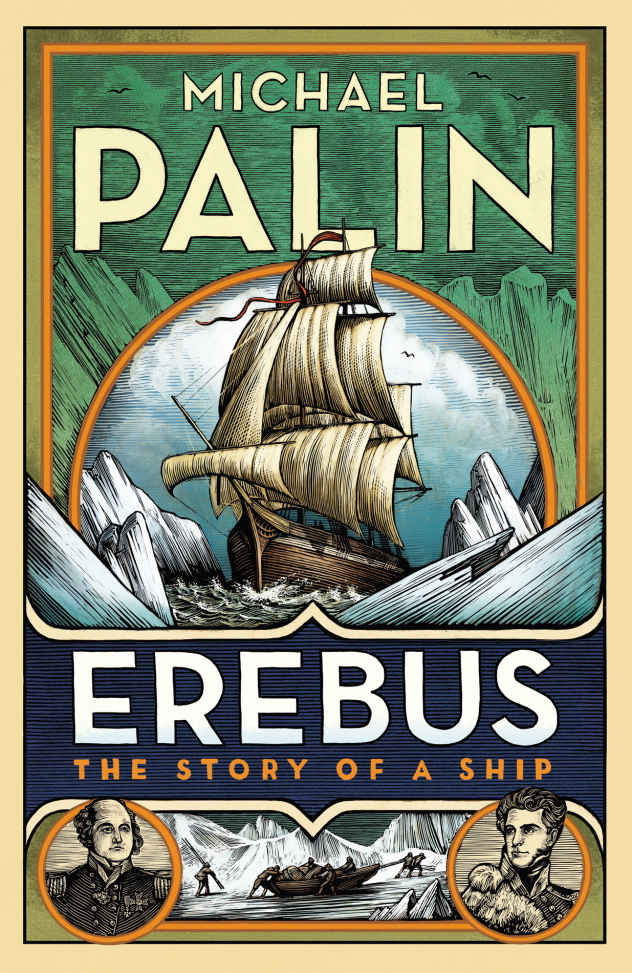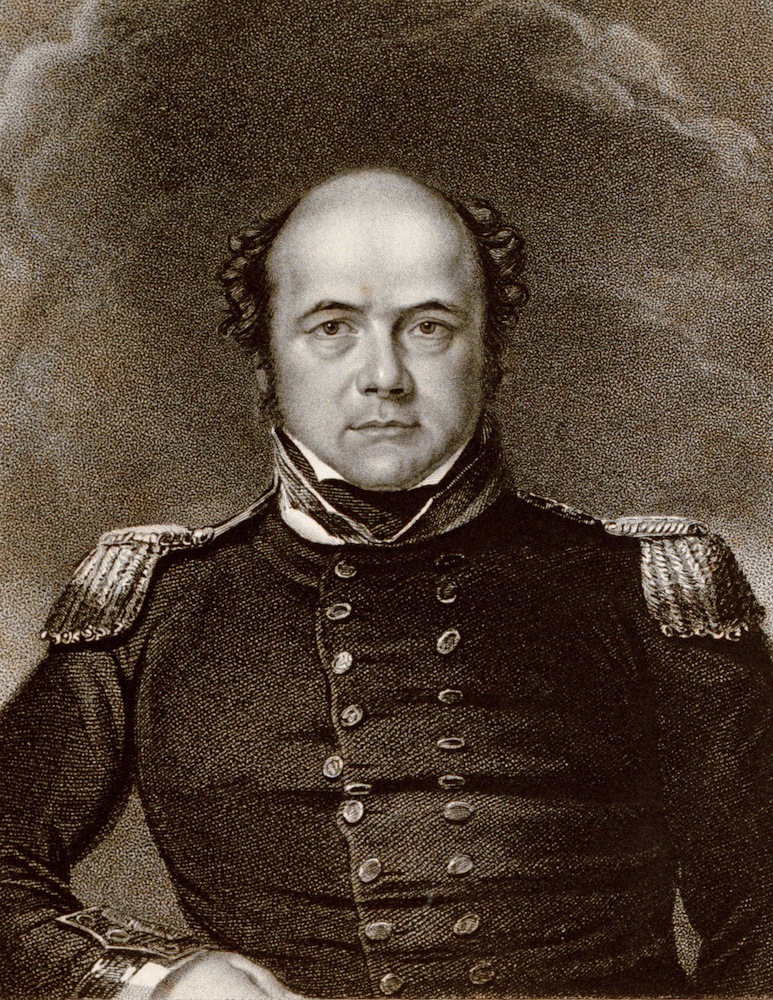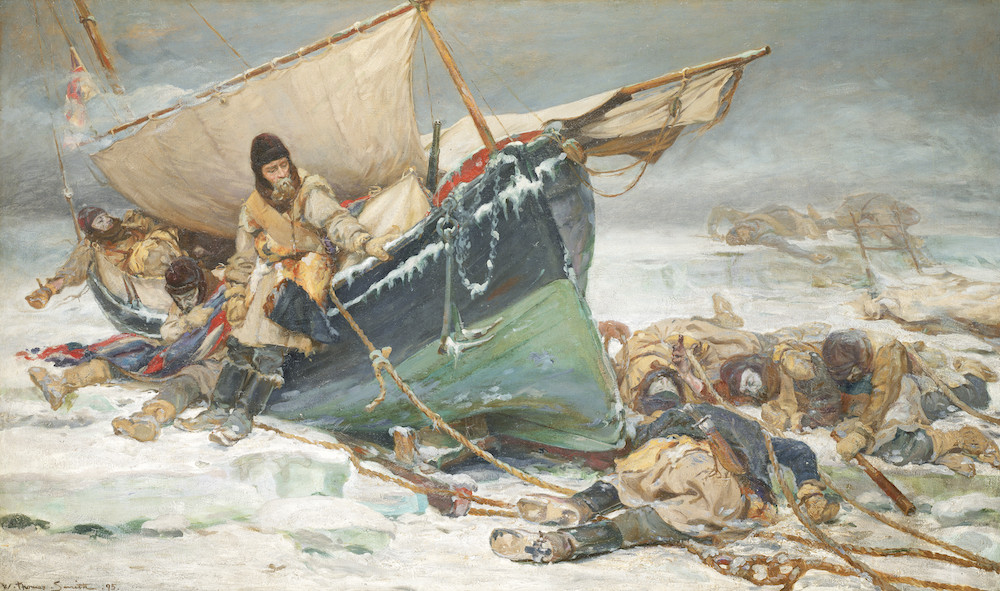
The ill-fated story of Sir John Franklin’s expedition to find the North-Western Passage has been told many times, and the discovery in recent years of his two ships, Erebus and Terror, has added impetus to a tale that has never failed to fascinate cultural and naval historians while also appealing to a wide general audience. It is a story combining certainties and mysteries, and the facts in the case of the Franklin expedition are well-known: in 1845 the expedition set off to the northern ice-pack, well-provisioned, manned by elite crews, led by experienced officers, housed in vessels which had already been tested in Antarctic waters and made as comfortable, with central heating and good accommodation, as mid-Victorian technology allowed. It was literally plain sailing for the first months but eventually the ships disappeared, and were never seen or heard of again – until 2014. It was only subsequent rescue attempts that revealed the desperate truth: all hands were lost, and in the struggle to survive the cream of Her Majesty’s Royal Navy had turned to cannibalism. It was, and remains, the largest British naval loss in peace-time, and one hard to accept; Dickens stridently refused to believe that these stalwart men would turn to such bestiality, and what had set out as a genuine piece of exploration descended into scandal and sensation. The Establishment was rocked.
In modern times the expedition has been reframed as a genuine mystery and the fate of Franklin’s men has been the subject of much speculation. Food-poisoning is strongly suspected, with botulism as a likely cause of the many deaths; solder-poisoning, with toxins ingested from inadequate seals used in canned food, another. It is equally likely that the command, led by the over-age Franklin, made a fatal error in allowing the ships to be iced-in while taking too long to set out for settlements in northern Canada, a mere 200 miles away, when supplies were low. The expedition’s incapacity to live off the land is another possibility, and it is well-known that the local Inuit encountered some starving white men who failed, nevertheless, to ask for assistance. All of these factors created a deadly brew. Worse, it is quite possible that the disaster was a simple descent into despair and confusion as these heroic Britons struggled with great physical and psychological adversity in the form of years of darkness and crippling cold. It is enough, as mid-Victorians might have said, to drive one to madness, and they may have been the victims of a terrible loss of reason.


Left: Franklin. Right: "They Forged the Last Link with Their Lives — Sir John Franklin's men dying by their boat during the North-West Passage expedition," by William Thomas Smith, 1895. Both © National Maritime Museum, London. [Click on the images to enlarge them, and for a review of the exhibition in which they featured.]
What, then, remains to be said? Michael Palin’s new study offers an interesting new perspective which places one of the ships, the Erebus, at the heart of the narrative. For those who only know the name through its association with the final tragedy, Palin’s book is a revelation, especially useful in filling in the back-story of how this rather mundane warship (being set up originally as a mortar-launcher) became an icon of suffering and loss.
Palin traces the story from the beginning, starting with her construction in Pembroke Dock in 1826–27. This was very much an Anglo-Welsh affair, with "oak from the Forest of Dean … shipped on barges down the River Severn" (9) and mainly built by local, highly-skilled labour. The next few years were a matter of under-employment, with routine tours in the Mediterranean and long periods in dock. The ship eventually became the mainstay of exploration as the Navy turned its efforts to colonial and scientific endeavour following the close of the Napoleonic Wars, when there was nothing else to employ its considerable fleet. Palin’s principal chapters are concerned with the expeditions to the Antarctic (1839–43); already paired with Terror, and captained by James Ross and Francis Crozier, the Erebus was involved in some of the most significant discoveries relating to the ever-changing icescape and meteorological conditions as the ships skirted the vast polar cliff-face and colossal bergs. Tried and tested in these deadly waters, Erebus was recommissioned on its return under Franklin’s leadership.

Lady Franklin as a young woman: a chalk portrait of 1816 by Amélie Romilly, ©National Gallery London (Primary Collection, NPG 904).
In telling this story Palin adds a great deal of interesting detail. The cast of characters – Franklin, Lady Franklin, Ross, Crozier, and a number of others ship-mates – are brought vividly to life in a series of daguerreotypes first published in the national press, and in telling commentary. Writing of Franklin, the author cleverly catches the sense of uncertainty, combined with that notion of never quite fitting in the right place, that may have been the expedition’s undoing. In the mid-thirties, we are told, Franklin was
respected, happy in his marriage – but at a loose end. There was no new posting to go to, and for the next three years he was effectively unemployed. It must have been a deeply frustrating time for him. Then, in 1836, a new opportunity arose, in the form of the lieutenant-governorship of Van Diemen’s lad. It was something of a poisoned chalice. [39]
Palin does not spell it out, but Franklin’s ability to drink a poisoned chalice not once but repeatedly is exactly what happened when he became the commander of the fatal expedition. Oppressed with the sense of never having achieved that much (his previous polar expedition in the 1820s had resulted in heavy loss of life, while he had been recalled from his lieutenant-governorship of Tasmania), Franklin was an impatient man, and one willing to accept whatever was offered. This was a man whose ambitions were propelled forward by his wife, who yearned to be the spouse of a hero, and Palin richly explores his partner’s political manoeuvrings as he flapped impotently on the side-lines. Working from the few communications that went home as the final journey progressed, Palin also suggests the dubious dynamics of his relationships with others on board, focusing not least on the fact that he is referred to as the Dickensian "dear" or "kindly old man" – barely the sort of image a commander should project to his crew as the two ships entered the most inhospitable terrain on earth. The original selection panel thought him too old at 59, and they may have been right; whatever illness afflicted the Erebus, killed Franklin first of all.

A bit of Wales in the North-West Passage: the wreck of the Erebus on the seabed, discovered in 2014. [Click on the image to enlarge it and for more information about it.]
These, and many other subtle nuances, are played out in this most interesting account as Palin explores everything from the ship’s material form to the characters and interactions of those who manned her. Not only an actor of great skill best known for his days with the Monty Python team, Palin has been a considerable traveller in his own right, and his experience presenting documentaries such as the BBC’s Pole to Pole very much informs his writing of this great but tragic adventure. Witty, meticulously researched and written with pace and clarity, it is an excellent addition to the Franklin literature. Unlike other accounts, it also has the virtue of a deeply personal engagement with the material. As a scholar, Palin researches some of his information from original documents, and as a traveller he retraces the many locations that shift from Pembroke, where the launching-tracks are still discernible, to the desolate resting places of the North-Western Passage. His final line, written after visiting the graves of the deep-frozen sailors, Braine, Torrington and Hartnell, is touching. "One day ... I’ll come back, this time with a scuba-suit, to see [the sunken wreck] for myself" (310). In his writing of Erebus we probably come as close to re-imagining the ship as we ever will, and Palin, yet another in pursuit of the missing expedition, is a most conscientious and able guide.
Work Cited
Palin, Michael. Erebus: The Story of a Ship. Hbk. London: Hutchinson, 2018. 334 pp. ISBN 13579108642. £20.00.